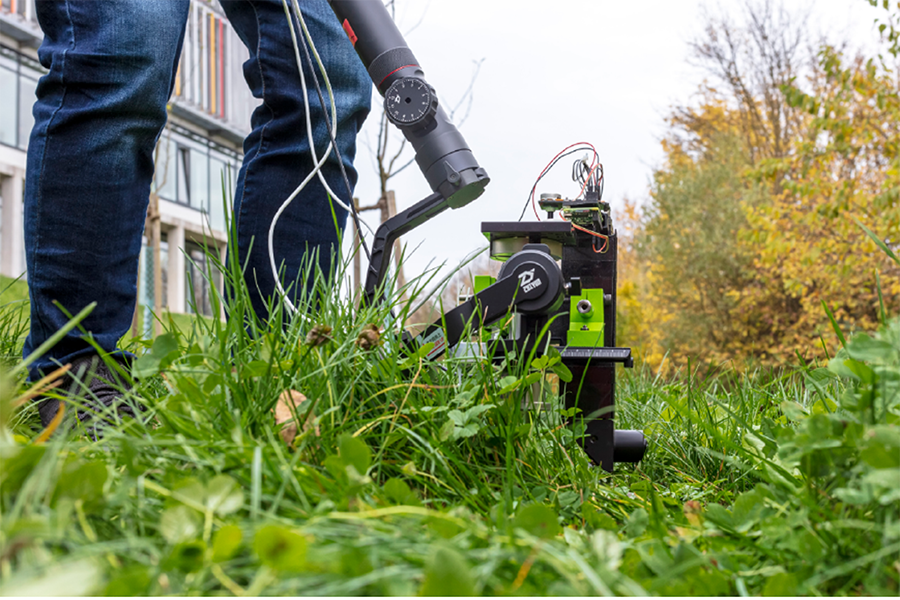Neurobiology: How mice see the world
Researchers based in Munich and Tübingen have developed an open-source camera system that images natural habitats as they appear to rodents.

A camera specifically designed to cover the spectral regions in the green and ultraviolet | © Y. Qiu, Euler Group
Bernstein member involved: Laura Busse
/UniTue/LMU/ The senses of an animal are shaped by the ecological niche it inhabits. This poses challenges but also opportunities for neuroscientific studies of an animal’s sensory systems. Mice, today a key mammalian model in vision research, occupy a different ecological niche compared to humans, and therefore have different behavioral needs. The visual system of mice has – unsurprisingly – adapted in a different way: For example, mice can see wavelengths of light invisible to our eye, in particular in their upper visual field. However, these adaptations are still rarely considered when studying the mouse’s visual system.
Within the DFG-funded collaborative research center (CRC) “Robust Vision”, researchers from the Institute for Ophthalmic Research at the Tübingen University and the Faculty of Biology at LMU Munich set out to fill this gap of knowledge. To advance our understanding of mouse vision, Qiu and colleagues have built a novel open-source camera to “see” the world from the mouse’s perspective. In their study, recently published in Current Biology, they recorded movies of mouse habitats with their camera and quantitatively characterized the acquired footage. They found that the statistics of the mouse’s visual environment are reflected in neural specializations already at the level of the retina.
The visual systems of animals evolved to efficiently process the stream of images coming from their natural environments and to support them in attending to their behavioral needs. Here, a prominent example for such adaptation is eye placement: Predators typically feature frontally-placed eyes, which enables depth vision in a large portion of their visual field and, hence, supports hunting behavior. In contrast, prey often have laterally-placed eyes, which maximizes their field-of-view – leading in some species to almost 360° vision – and ensures that they detect a predator no matter from which side it approaches.
In past decades, mice have become a prominent animal model for studying vision. They possess three types of photoreceptors: In addition to rod photoreceptors and medium wavelength-sensitive (M) cone photoreceptors – both being maximally sensitive around 510 nm (green) – they also feature a short wavelength-sensitive (S) cone photoreceptor peaking at 360 nm light, which is in the UV band invisible to us. Moreover, other than in humans, the two cone photoreceptor types are distributed unequally across the mouse retina, resulting in higher sensitivity for UV in the upper visual field, and a higher sensitivity for green in the lower visual field.

Black drone (encircled) at twilight in the camera’s two chromatic channels – as it is presumably seen by mice.
With these features of mouse vision in mind, the teams of Prof. Thomas Euler (U Tübingen) and Prof. Laura Busse (LMU) developed an open-source camera system for recording video footage in the spectral bands that mice see – UV and green – with a field-of-view of nearly 180°. Such video recordings were performed near mouse habitats, at different times of a day, for different seasons and scenes. This footage is publicly available for research use (https://doi.org/10.5281/zenodo.4812404).
Next, the authors analyzed the contrast distribution of the two chromatic channels, for different parts of the visual fields. Analysis of the recorded footage revealed that chromatic signals were richer in the upper compared to the lower visual field, a characteristic pattern in the visual environment of mice. To understand whether this characteristic pattern in the visual scene was sufficient to drive the emergence of retinal specializations for processing color – that is the aforementioned horizontal division of the visual field – the authors used a computational neural network model. Indeed, when this artificial network was trained with images from the upper visual field, the network developed “color vision”, similar as found in the mouse retina.
So why do mice have this ability to see UV light? This question is intriguing, in particular since UV wavelengths can damage the eye on the long run, which is why most UV is filtered out by the optics in our eyes before it reaches the retina. To test if UV vision might help mice detecting predators in the sky, the authors collected footage also at dusk and dawn, and simulated an approaching bird of prey by flying a black remoted controlled drone. They found that the drone was much more easily detectable in the UV than in the green camera channel, suggesting that UV vision may reduce the risk for mice being eaten when they roam for food during twilight.
Taken together, this study supports the view that the statistics of the natural environment shaped the visual system during evolution. Furthermore, the findings stress the necessity of vision research in the context of the environment the animals evolved in.
Text: PM Uni Tübingen.
Youtube Clip
Imaging the environment as it would appear to a mouse. (The UV channel is coloured in blue.) Source: Yongrong Qiu, Euler Group. >> to the youtube clip
Publication
Yongrong Qiu et al: Natural environment statistics in the upper and lower visual field are reflected in mouse retinal specializations. Current Biology 2021




